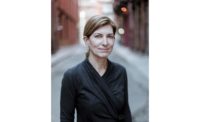Interview with Gene Kohn
Deputy editor Suzanne Stephens chatted with the KPF founder about topics discussed in his new book.

Photo © John Chu / KPF
Architects & Firms
Eugene Kohn’s conversational autobiography, The World by Design: The Story of a Global Architecture Firm (written with former RECORD deputy editor Clifford Pearson), can be refreshingly candid. Kohn, who grew up in Philadelphia and studied architecture at the University of Pennsylvania, founded Kohn Pedersen Fox (KPF) in New York on Bicentennial Day, July 4, 1976, with William Pedersen and Sheldon Fox. Of course, Kohn basks in the office’s achievements as it morphed into a large firm (over 650 employees) with a strong design reputation (it ranks as number 20 in RECORD’s top 300 architecture firms of 2019). Buildings such as 333 North Wacker in Chicago (1983) are significant milestones. Yet the book also deals with setbacks the office has faced along the way, including an insurrection initiated in 2009, when partners in the London office left and formed PLP Architecture. Kohn moved temporarily to London to retain both KPF staff and its roster of projects, including the Abu Dhabi International Airport’s Midfield Terminal Complex (2019). Deputy editor Suzanne Stephens asked Kohn to elaborate on certain topics discussed in the book.
What turned you on to architecture?
When I went to Penn, I was not sure what I wanted to do. But my passion for this field developed through all the inspiring architects who taught or lectured there, including Louis Kahn, Paul Rudolph, and Le Corbusier.
You write about how influential Charlie Ogg, of the Philadelphia architects Nolen & Swinburne, was to you.
I was working there after graduation and Charlie gave me the best advice ever. He said map the project and think about all the aspects of the building first—plans, sections, and elevations—before you start to draw. This way, you understand its complexities.
KPF’s work in Asia shows an ability to deal with complexity. A multiuse structure such as the International Commerce Center in Hong Kong (2011), which is tied into transit, is one example. The Shanghai World Financial Center (2008) has a simple elegance. What are the advantages in working in Asia?
Working in Asia has protected us from downturns in the U.S. economy and helped develop expertise on complex, high-quality projects.
Yet the firm has been criticized recently for that kind of work at Hudson Yards—Michael Kimmelman included KPF’s architecture in his takedown of the development in The New York Times.
I am not sure if public critics appreciate the problems of planning this area of New York over railroad tracks. Tech and investment banks need large spaces, so the shape of buildings is dictated by floor-size requirements. Architects doing commercial projects find that economy, budget, function, and the market all factor in. And, remember, the towers were designed 12 years ago.
Shelley Fox died in 2006, and now you and Bill Pedersen are taking less active roles. How are you dealing with succession?
We have always planned for succession—to keep the firm going after the founding partners retire or die—so our employees could see a future here. We try to hire people who are as good as or better than we are. But we have lost terrific talent, such as Greg Clement and Paul Katz, who both died at a young age. Lee Polisano, who headed our London office and wanted to split it off from our New York base, left, and I found myself shoring up the London office. Now it is busier than ever. Overall, we have a great team of architects, such as the current president, Jamie von Klemperer. You need a deep bench of players committed to teamwork.
What about architects starting out today who fear getting lost in a large corporate firm?
We are attracting young designers just out of school, and we want to develop them in-house. I wish we could pay them more—investment firms can offer $185,000 a year as starting salary. However, we have a lot going, with such events as guests’ giving lectures or participating in critiques. While we allow design freedom to our partners, we also will criticize their work.
You have been known as an impressive diplomat, leader, and rainmaker. But you also paint—particularly watercolors.
I started learning from my mother when I was 5. At age 100, she exhibited 100 of her paintings in the Guggenheim Museum. She lived to 106. And I still do watercolors, which we use as the firm’s holiday cards.
Do keep us on your list.




